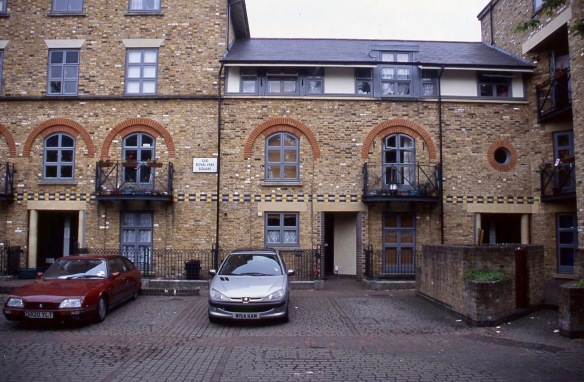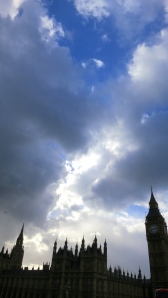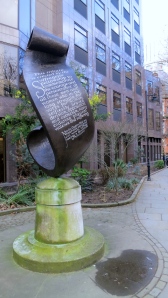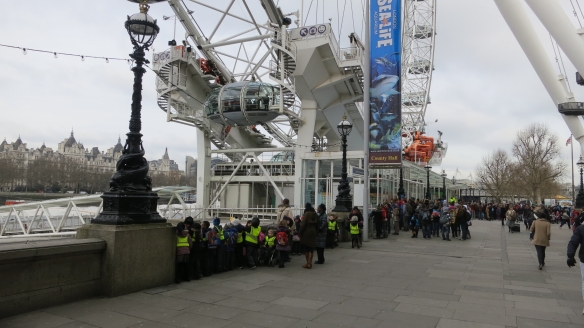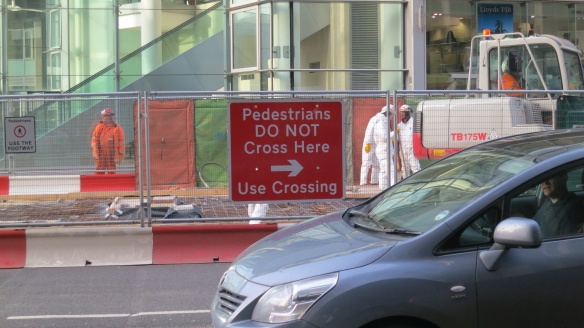CLICK ON LONDON IMAGES TO ENLARGE. REPEAT IF REQUIRED. CLICKING ANY GARDEN PICTURE ACCESSES THE GALLERY, EACH ONE OF WHICH CAN BE VIEWED FULL SIZE BY SCROLLING DOWN AND CHECKING BOX AT BOTTOM RIGHT.
Today the sun slunk back behind the newly whitewashed ceiling from which occasional leaks did spring.
In July 2005 the weather was finer, so I took a trip back there in the form of scanning another dozen colour slides of the Streets of London series.
Unless they’ve relocated to much grander property in Wisconsin, Double K’s Snack Bar in the aptly named Sandwich Street WC1 is probably no longer trading.
The mural on this corner of the Lewis Carroll Library in Islington’s Havelock Street has not escaped the attentions of a graffiti spray can. Its premises in Copenhagen Street N1 currently appear to be rather more splendid. This is a popular educational resource for children and adults.
A palette and bags of building materials in Freeling Street serve as a seat for a worker taking a break for refreshments and phone conversation.
A typical London corner shop stands on this corner of Chapel Market and Penton Street.
At the close of the 18th century townhouses with rear gardens were built along what was then Chapel Street, when it formed the eastern boundary of the new suburb of Pentonville. A fire engine house was erected in 1792 and heightened in 1822; it survives today but in poor condition.
http://hidden-london.com/gazetteer/chapel-market/ gives us this information about the market:
‘The essayist Charles Lamb lived at two addresses in Chapel Street in the late 1790s.
To the annoyance of the well-heeled residents, costermongers began to sell their wares along the street during the 19th century and by the 1860s a fully-fledged and relatively reputable market was in operation. Official designation as a street market came in 1879.

Three years later John James Sainsbury opened his first Islington store at 48 Chapel Street, managed for a while by his eldest son, John Benjamin. The venture was so successful that the Sainsburys opened three more shops in the street, including their first branch specialising in poultry and game.
By the 1890s Chapel Street had one of the two largest markets in the Clerkenwell and Islington areas, divided roughly equally between food and non-food stalls. Furniture, earthenware, second-hand clothing and drapery were among the most popular merchandise. The council renamed the street Chapel Market in 1936.
A few mainstream retailers and fast food outlets now occupy premises towards the eastern end of the street but for the most part this remains a traditional and unpretentious market, selling mainly household goods and food. It is open every day except Monday. Despite its continuing popularity, Chapel Market is vulnerable to a future change of use owing to the high value of land in Islington.’
The Victorian Royal Free Hospital began life as The London Fever Hospital. By the 1990s this redundant facility was redeveloped for varying types of residential accommodation. http://www.locallocalhistory.co.uk/islington/royalfree/ has much interesting history on this site, modern manifestations of which include
Old Royal Free Square N1
and Southwood Smith Street N1
London’s feral pigeons are ubiquitous. Here a trio dice with death near a corner of Battishill Street.
I do hope the driver of this Urgent Courier in Kember Street had managed to deliver his package before his van was clamped.
The gentleman on the balcony in Bernard Street WC1 appears to have scaled great heights in search of a mobile phone signal.
Now, can you spot Louisa and Errol outside the Victoria Palace Theatre?
I’ll give you a clue. The woman in white conversing on her mobile stands beside them when the traffic crossing figure is green. It becomes red while she approaches me, still apparently engrossed in the screen.
These three shots were all taken from outside an Indian restaurant where the three of us had enjoyed a pre-theatre meal before seeing the show, aptly described on the board as ‘The Greatest British Musical I’ve Ever Seen’.
Once more, by late afternoon, the sun shone from a gently clouded blue sky.
This evening we dined on Jackie’s superb sausage casserole and mashed potato flecked with carrot. She drank Hoegaarden and I drank Barossa Valley Shiraz 2016.




